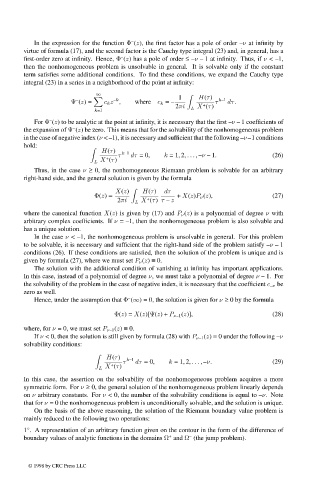Page 629 - Handbook Of Integral Equations
P. 629
–
In the expression for the function Φ (z), the first factor has a pole of order –ν at infinity by
virtue of formula (17), and the second factor is the Cauchy type integral (23) and, in general, has a
–
first-order zero at infinity. Hence, Φ (z) has a pole of order ≤ –ν – 1atinfinity. Thus, if ν < –1,
then the nonhomogeneous problem is unsolvable in general. It is solvable only if the constant
term satisfies some additional conditions. To find these conditions, we expand the Cauchy type
integral (23) in a series in a neighborhood of the point at infinity:
∞ 1 H(τ)
–
–k
Ψ (z)= c k z , where c k = – τ k–1 dτ.
+
2πi L X (τ)
k=1
–
For Φ (z) to be analytic at the point at infinity, it is necessary that the first –ν – 1 coefficients of
–
the expansion of Ψ (z) be zero. This means that for the solvability of the nonhomogeneous problem
in the case of negative index (ν < –1), it is necessary and sufficient that the following –ν–1 conditions
hold:
H(τ) k–1
τ dτ =0, k =1, 2, ... , –ν – 1. (26)
+
X (τ)
L
Thus, in the case ν ≥ 0, the nonhomogeneous Riemann problem is solvable for an arbitrary
right-hand side, and the general solution is given by the formula
X(z) H(τ) dτ
Φ(z)= + X(z)P ν (z), (27)
+
2πi L X (τ) τ – z
where the canonical function X(z) is given by (17) and P ν (z) is a polynomial of degree ν with
arbitrary complex coefficients. If ν = –1, then the nonhomogeneous problem is also solvable and
has a unique solution.
In the case ν < –1, the nonhomogeneous problem is unsolvable in general. For this problem
to be solvable, it is necessary and sufficient that the right-hand side of the problem satisfy –ν – 1
conditions (26). If these conditions are satisfied, then the solution of the problem is unique and is
given by formula (27), where we must set P ν (z) ≡ 0.
The solution with the additional condition of vanishing at infinity has important applications.
In this case, instead of a polynomial of degree ν, we must take a polynomial of degree ν – 1. For
the solvability of the problem in the case of negative index, it is necessary that the coefficient c –ν be
zero as well.
–
Hence, under the assumption that Φ (∞) = 0, the solution is given for ν ≥ 0 by the formula
Φ(z)= X(z)[Ψ(z)+ P ν–1 (z)], (28)
where, for ν = 0, we must set P ν–1 (z) ≡ 0.
If ν < 0, then the solution is still given by formula (28) with P ν–1 (z) ≡ 0 under the following –ν
solvability conditions:
H(τ) k–1
τ dτ =0, k =1, 2, ... , –ν. (29)
+
X (τ)
L
In this case, the assertion on the solvability of the nonhomogeneous problem acquires a more
symmetric form. For ν ≥ 0, the general solution of the nonhomogeneous problem linearly depends
on ν arbitrary constants. For ν < 0, the number of the solvability conditions is equal to –ν. Note
that for ν = 0 the nonhomogeneous problem is unconditionally solvable, and the solution is unique.
On the basis of the above reasoning, the solution of the Riemann boundary value problem is
mainly reduced to the following two operations:
◦
1 . A representation of an arbitrary function given on the contour in the form of the difference of
+
–
boundary values of analytic functions in the domains Ω and Ω (the jump problem).
© 1998 by CRC Press LLC
© 1998 by CRC Press LLC
Page 612

